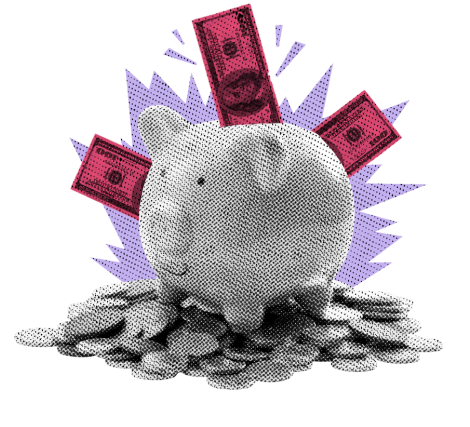
Inflation, weak consumer confidence, and falling personal spending hint at what’s coming. The market already knows.
KEY TAKEAWAYS
- Inflation is rising and still above Fed targets, especially in services, but durable goods are starting to look worrisome with tariffs locked and loaded.
- Consumer confidence and long-term inflation expectations are worsening.
- Personal spending came in lower than expected and was revised downward.
- The S&P 500 and Treasury yields are already signaling market concern.
- Stagflation risk is emerging—rising prices with slowing growth.
MY HOT TAKES
- The Fed’s inflation narrative is losing credibility—expectations are clearly not anchored.
- Consumers are tapped out, and confidence is cracking under the weight of persistent inflation.
- Markets lead the economy, and they’ve already priced in deterioration.
- The administration is getting clear warnings—both economic and market-based.
- Stagflation isn’t a theoretical risk anymore—it’s knocking on the door.
- You can quote me regarding anchored inflation: "If I were in a boat that was supposed to be anchored, and I noticed that the rocks in the distance were starting to get bigger… well, you know.”
Deep tissue trauma. Have you ever solved the eternal riddle of what comes first, the chicken, or the egg? If you have, great, but for most of us, finding that answer is still a work in progress. Let’s instead focus, this morning, on a riddle that can be solved. What comes first, the market, or the economy?
On Friday, markets received some economic numbers that couldn’t have painted a more uncomely portrait of the US economy. Was it a picture of declining economic growth? Is GDP declining? Are corporate earnings falling? Are we in an earnings recession? Calm down! The answers are no, no, no, and no… yet.
Starting with the PCE Price Index, which is the Fed’s favored gauge of inflation, the Bureau of Economic analysis reported on Friday that core inflation grew by a greater-than-expected 2.8%, and it revised last month’s figure up by 0.1% to 2.7%. Now, these may seem like marginal increases with nothing to worry about, but remember, 2% is the Fed’s target and we are moving in the opposite direction. This means that prices of goods and services are growing by 2.8% year over year and that price growth is accelerating. This should concern the Fed, and everyone that wants the Fed to cut interest rates. The bulk of inflation is still in services, which are less affected by tariffs, but durable goods inflation which is DIRECTLY affected by tariffs is trending in the wrong direction, which means it could soon have a material impact on the headline figure that we are all obsessed with.
Next, let’s focus on consumption, you know that thing that I obsessively rant about all over my videos, blog posts, and yes, even TV. I am obsessed with it because it is the single biggest component of GDP (~70%). If we keep buying more and more stuff, GDP will grow. What would cause us to buy less stuff? Well, inflation could cause us to spend less, and that picture doesn’t appear to be improving, as mentioned in the previous paragraph. 🙃☝️ If things are more expensive, then we will buy less of them. It’s just economics, silly.
While we are on the topic of consumers buying less due to inflation. We all know that prices fluctuate in the near-term. However, if we believe that inflation will be stable in the future, it is not likely to affect our purchasing habits. That is referred to as anchored inflation. If inflation becomes un-anchored (if that is even a word), we have a bit of trouble on our hands. Let me explain. If consumers are expecting inflation to grow and that expectation is growing, consumers will respond by purchasing less.
Fed Chairman Powell stated several times in his last press conference that he believed that inflation is anchored. Well, Friday’s numbers called 🐂💩 on that notion, when University of Michigan released the final monthly revision of its Sentiment series. The indicator polls consumers on, amongst other things, near and long-term inflation expectations. Well, both were revised up from earlier estimates, higher than estimates, with 1-year inflation at 5.0% (that is not a typo), and 5–10-year inflation at 4.1%. If I were in a boat that was supposed to be anchored, and I noticed that the rocks in the distance were starting to get bigger… well, you know.
University of Michigan’s Sentiment figure also painted a less-than-flattering picture of consumer sentiment, revising it down by 0.9% while economists were looking for no revision. The decline is attributed to future expectations. That brings me to my favorite quote: “confident consumers consume,” and right now, my friends, confidence is slipping.
I have just painted a picture of a scenario which could set the stage for a decline in consumption. Inflation heading in the wrong direction: ✔️, inflation that is unanchored with higher inflation expected: ✔️, and declining consumer confidence: ✔️. What about actual consumption? We can track that too, and guess what, on Friday, we learned that Personal Spending in February was lower than economists were expecting, and that the prior month’s decline was revised downward. That all simply means that consumption may be softening.
That brings us back to the conundrum of what comes first. Well, I’ll have a go at it.
Inflation ➡️ inflation expectations rise ➡️ decline in consumer sentiment ➡️ consume less ➡️ GDP slows
Now, I will just make a quick mention of Investment which is another component of GDP, mostly driven by companies. If economic conditions are expected to get dicey and if management is uncertain of what the business climate will be like in 6 to 18 months, is it possible that management might slow down capital investment? Of course, it is. What about hiring? Could hiring slow, and worse yet, could layoffs increase in an attempt to reclaim margin lost to tariffs? Of course! In fact, labor is the simplest variable cost to switch around. So, less investment also leads to a decline in GDP, and a soft labor market leads to further decay in consumer confidence.
This week we will get some PMI or Purchasing Manager Index releases. You can think of PMIs like corporate confidence, so these, like consumer confidence are great leading indicators to behavior. This week, we will also get a read of the labor market from March. This is likely to be the first to reflect some of the DOGE cuts, which could put another dampener on consumption growth.
So, while some of the economic indicators show an economy still very much standing on its two feet, the leading indicators are starting to show signs of exhaustion. Wait, so where does the market fit into all of this? Well, through Friday, the S&P 500 has fallen by -7.74 since inauguration. What’s more, 10-year Treasury Note yields have declined from 4.57% to 4.18% as bond traders are factoring in trouble ahead for the economy. While some sectors will welcome lower 10-year yields, it is clear that declines have come for the wrong reasons. Lower mortgage rates are meaningless for furloughed or out-of-work borrowers.
Folks, this is nothing short of a mess in the most classic economic sense. These are seeds of stagflation, which is the nightmare of all economists–declining growth combined with rising inflation.
Markets have obviously cast their votes on the situation, and the prognosis is not positive. What’s more, declining markets can also chip away at confidence and consumption as the wealth effect diminishes.
Now, I am going to restate the original riddle. What comes first, the chicken, the eggs, or the scrambled eggs. That is an easier one to solve. The markets and economy are both sending the President a clear message: “don’t do it.”
FRIDAY’S MARKETS
Stocks got beaten up on Friday after a series of economic numbers confirmed the worst–tariffs have put the economy on a course for the rocks. With no respite on the horizon investors chose to send the SOS signal wondering if anyone is even listening.

NEXT UP
- MNI Chicago PMI (March) may have slipped to 45.0 from 45.5.
- Dallas Fed Manufacturing PMI (March) probably improved slightly to -5.0 from -8.3. Why are these numbers negative? Because these are all listed relative to the indexes base year and the current readings are below that year. We, therefore, focus on the direction of the numbers. In other words, less negative numbers are better–weird but, facts.
- Later in the week we will get more regional Fed reports, S&P final PMIs, ISM PMIs, ADP Employment Change, JOLTS Job Openings, Factory Orders, and monthly employment numbers.
.png)

